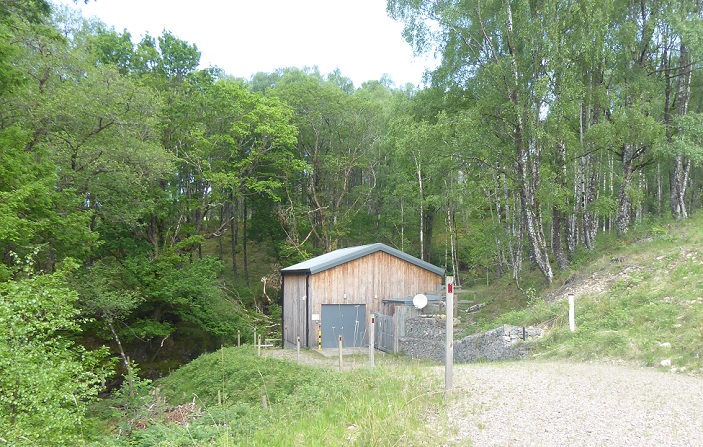
I have been out and about quite a bit over the last month and its got me thinking about run of river hydro schemes again, from both a climate change and a nature perspective.
While promoted by both Scottish Government policy and developers as a means of providing renewable energy and of reducing our carbon emissions, there has never been any proper carbon accounting in Scotland for these schemes. They have just been assumed to be “clean and green” (see here). This post uses a couple of examples from the Allt Mhuic run of river hydro: these may appear small but illustrate the much greater problem.

The Allt Mhuic hydro scheme, like four others on the north side of Loch Arkaig, is on land owned by Locheil Estates part of which, including the butterfly reserve, is leased by Forestry and Land Scotland (FLS). I have commented before on the use of these unsightly marker poles on FLS land (see here) but, from a carbon perspective, the plastic is a product of the oil industry which could and should have been left below ground. By contrast, wooden posts are a renewable resource.
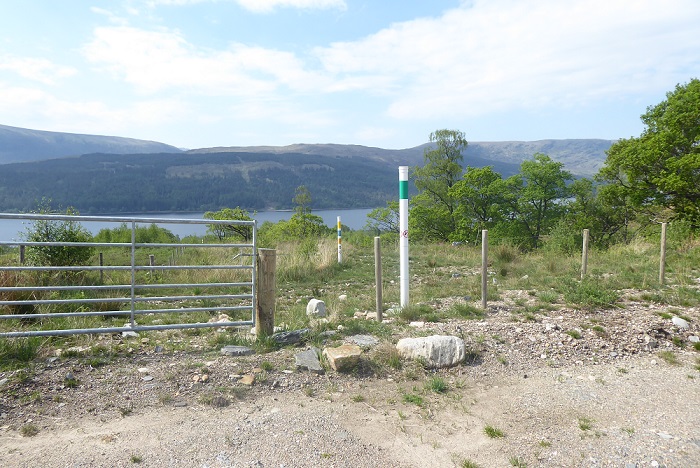
It says something about FLS’ blindness about the carbon impact of these schemes and its potentially important role as Scotland’s largest landowner in mitigating climate change that it did not insist that the developers use wood for marker posts. If FLS cannot advocate for its own products as being better then plastic, who will?

The developers and their consultants also bear a high degree of responsibility for the unnecessary use of fossil-fuel derived products in run of river hydro schemes. Driven by profit, they will always take the financially cheapest option if allowed to do so.
Further up the hillside, the green hypocrisy, became even more striking:
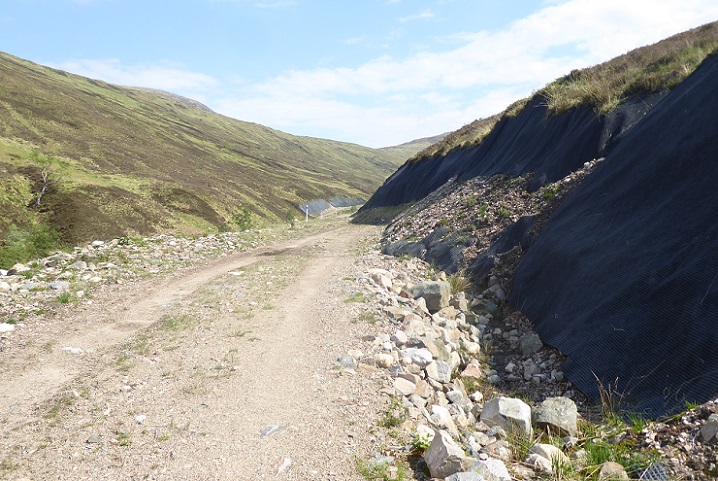
The Allt Mhuic intake dam is located in this narrow glen. Even though it is in what is supposed to be a Wild Land Area and even though their guidance on hill tracks advises against cutting roads across steep hillsides such as this, NatureScot did not object to the application. Highland Council noted the problem of this road in its Committee Report on the planning application (see here):
“Benching is proposed here with steep embankments on the upslope side which would be stabilised using geotextile membrane”
Geotextile membranes can be manufactured out of various products, some sustainable, some not. On closer inspection and touch the one used along the All Mhuic appeared to have been made out of plastic: :
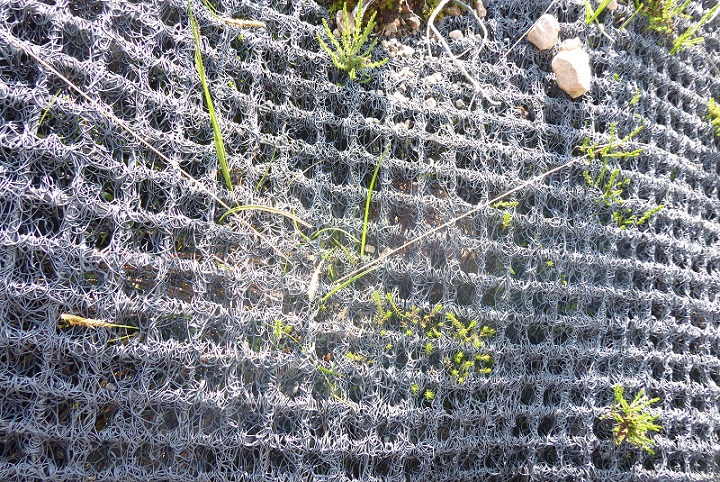
The Construction Method Statement is no longer on the Highland planning portal so it is unclear if officials or councillors knew that plastic would be used but, whatever the case, no conditions were made as part of the planning consent on the use of non-fossil fuel derived materials where possible.

If run of river hydro schemes had had to submit carbon calculators, like the tree planting schemes registered under the carbon code, one wonders how many emissions would have been accounted for by all this plastic?
While there are serious problems with the woodland carbon code calculator, which underestimates the amount of emissions caused by soil disturbance, at least there is now a tool for evaluating the carbon impact of tree planting projects and how long they take to repay the carbon they emit. The standard time developers such as BrewDog now allow for native woodland planting on shallow peaty soils to recoup carbon emissions is 15 years (see here). For hydro in Scotland there is nothing.
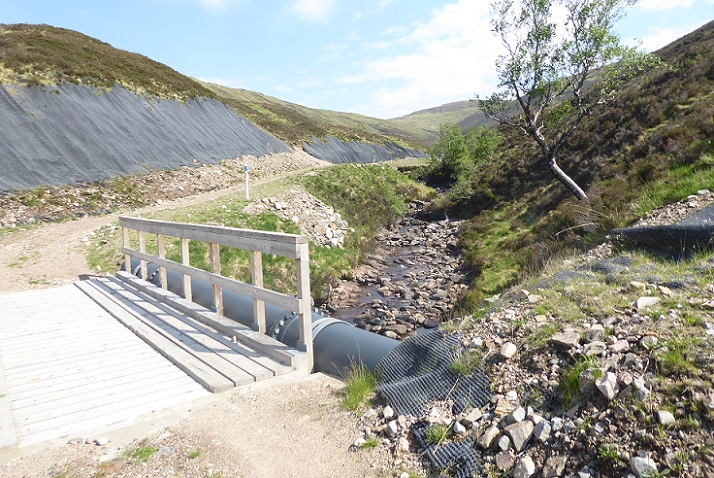
Were such a carbon calculation tool to exist, it would help planning authorities to determine whether run of hydro schemes such as the Allt Mhuic or other “green” energy schemes should go ahead. The fundamental question that needs answering is how does all the carbon released by soil disturbance, the manufacture of steel and concrete, the use of machinery etc compare to the energy that will be produced by a scheme in its lifetime?
Where renewable energy schemes were shown to have a positive impact on carbon emissions over their lifetimes, such a calculation would also help minimise unnecessary use of fossil fuels and their products in their construction and management, including polluting plastic.
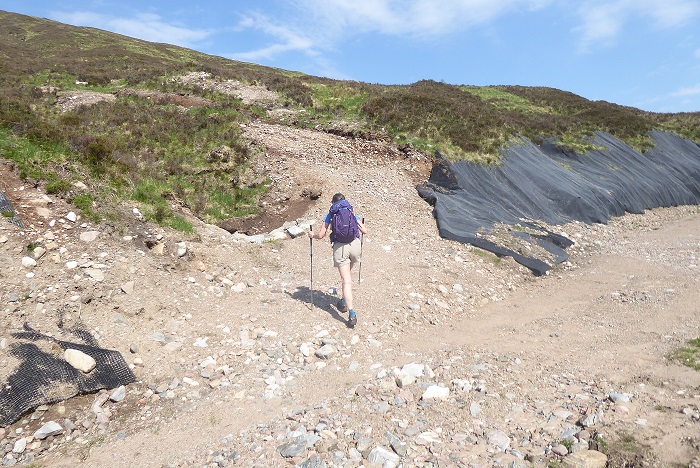
A renewables carbon calculator would therefore focus minds on addressing climate change, rather than the money making potential these schemes offered to landowners and developers before the Feed in Tariff was abolished. That would be significant step forward. The importance of “ecodesign” in run of river hydro schemes if they are to make a difference has recently been emphasised in American research (see here).
The implications of hydro scheme carbon calculators
It is significant that no-one in the Scottish Government thought to require developers to produce “Life Cycle Assessments” of carbon emissions and carbon balance sheets during the run of river hydro frenzy caused by the Feed in Tariff. The Scottish Government’s principal concern, reflected in policy, was the development of renewable energy at any cost without any consideration of whether run of river of hydro schemes made sense in terms of reducing our carbon emissions.
It is little wonder Scotland has failed to meet and has now been forced to abandon its climate change targets for 2030. The use of plastic products is just a symptom of a much deeper underlying problem, the need to stop the unnecessary use of fossil fuel derived products. At present almost no-one in government appears prepared to grasp that particular thistle and acts as though they are powerless in the face of “the market”.
Interestingly much of the research on Life Cycle Assessments of hydro schemes appears to come from developing countries, like that from India (link above), rather than developed countries such as Scotland or the wider UK. Now the main issue facing Scotland is not run of river hydro schemes, which have dried up along with the Feed In Tariff, but pumped storage schemes for which government is promising yet more guaranteed income flows at public expense.
According to SSE Pumped Storage Hydro is all clean and green (see here). While there is no doubt that SSE’s arguments that pumped storage is much better than traditional fossil fuel power stations and does enable much better use to be made of renewable power, they fail to mention of the carbon costs of these schemes. That is no accident. Recent research from China (see here) indicates that the lifetime carbon emissions of such developments is considerable and sets out a methodology for assessing them. The research is not arguing that such schemes are not justified, only that we should not be blind to their carbon costs.
Such costs appear to me relevant when it comes to determining pump storage schemes like the proposed Earba development (see here). How would the emissions caused by constructing a large dam, power station etc on the Ardverikie Estate compare to other locations or compare to other options?
Unfortunately, rather than requiring developers to submit detailed assessments of the carbon costs, the Scottish Government via its Energy Consents Unit basically leaves decisions about the location and carbon costs of such schemes to the private market. There is no mention of the need to calculate carbon costs in the Scottish Government’s good practice guidance (see here). As a consequence it is unable to make any assessment about which of the pumped storage schemes currently being considered would have the least impact in terms of carbon, i.e how long each would take to pay back its lifetime emissions.
The Scottish Government’ss hands-off approach will also result in a repeat of all the mistakes and unnecessary emissions caused by tiny schemes like the Allt Mhuic but on a huge scale. Even if the Scottish Government’s only concern is about how to address global warming, and it has no interest in other matters like their impact on landscape and nature, this makes no sense.
Its surely time for the Energy Consents Unit to adopt carbon calculators and have them independently verified before determining any large-scale development and for Planning Authorities to do the same for smaller schemes. Our National Park Authorities, which have a legal duty to promote sustainable development, could have been taking a lead here. Instead they have acted just like other local authorities which have no such legal duty: the Allt Mhuic scheme is little better and little worse than the many run of river hydro schemes that were developed in the Loch Lomond and Trossachs National Park.

Good to see the question of life cycle assessment being given the prominence it deserves. It’s a sad indictment of SG policy – or lack thereof – that the matter of carbon cost has routinely been swept aside in the dash for renewable energy at any price. I wonder, though, how much this would have counted in the assessment of RoR hydro schemes at the time, given the promise of community benefit attached to them. My memory could be playing tricks, but something tells me there was definitely one Arkaig RoR – quite possibly this one, in fact, considering that the butterfly reserve was a key habitat for the endangered chequered skipper – that was turned down by the planners initially, only for the decision to be overturned after local protests.
Some of the earliest -feed-in-tariff- RofR schemes will by now be nearly a quarter century old.
Publicity has been given to some schemes where the catchment filter structure for the pen stock has failed….either under-cut by further erosion or totally blocked by debris.
Considering the public subsidies, and favourable feed-in rates possible, and then recalling the enthusiastic planning ambivalence in face of wholesale trashing of so many glens, which public authority in Scotland has the investigators. Who ever checks on those schemes that have failed.?
Which planning office enforces the reinstatement conditions on Land managers that have built useless schemes that deliver no power much of the year, or greedily commissioned poorly designed structures at huge pubic subsidy expense that never did deliver much power?
Aha, a very good question to which I suspect we all know the answer: nobody and no-one! I recently came across a screamingly awful hydro track gouged high up into the flank of Rois Bheinn. It was so steep and stony that I could not walk down it without risk of slipping and falling. It “served” the tiniest “weir” I have ever seen, athwart a modest little burn that looked unlikely to carry much water other than in times of torrential rain. A huge waste of public money and an eyesore visible for miles around, including to kayakers on the sea.